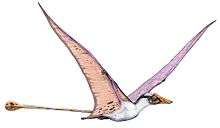Scleromochlus
| Scleromochlus | |
|---|---|
 | |
| Skeletal diagram | |
| Scientific classification | |
| Kingdom: | Animalia |
| Phylum: | Chordata |
| Clade: | Archosauria |
| Clade: | Avemetatarsalia |
| Family: | †Scleromochlidae Huene, 1914 |
| Genus: | †Scleromochlus Woodward, 1907 |
| Species: | †S. taylori |
| Binomial name | |
| Scleromochlus taylori Woodward, 1907 | |
Scleromochlus (Greek for "hard fulcrum") is an extinct genus of small avemetatarsalians from the Late Triassic period.
Description

Scleromochlus taylori was about 181 mm (about 7.1 inches) long, with long hind legs; it may have been capable of four-legged and two-legged locomotion. Most recent studies about its gait suggest that it engaged in kangaroo- or springhare-like plantigrade hopping;[1][2][3] if Scleromochlus is indeed related to pterosaurs, this may offer insight as to how the latter evolved, since early pterosaurs also show adaptations for saltatorial locomotion.[4]
Discovery
Its fossils have been found in the Carnian Lossiemouth Sandstone of Scotland. The holotype is BMNH R3556, a partial skeleton preserved as an impression in sandstone; part of the skull and tail are missing.[5]
Scleromochlus is a monotypic genus (single species), including the type species S. taylori.
Classification
A lightly built cursorial animal, its phylogenetic position has been debated; as different analyses have found it to be either the basal-most ornithodiran, the sister-taxon to Pterosauria, or a basal member of Avemetatarsalia that lies outside of Ornithodira. In the phylogenetic analyses conducted by Nesbitt et al. (2017) Scleromochlus was recovered either as a basal member of Dinosauromorpha or as a non-aphanosaurian, non-pterosaur early avemetatarsalian. However, the authors stressed that scoring Scleromochlus was challenging given the small size and poor preservation of the fossils, and stated that it could not be scored for many of the important characters that optimize near the base of Avemetatarsalia.
References
- ↑ Sereno et Arcucci 1993; 1994
- ↑ Benton 1999
- ↑ Witton, Mark P. (2013). Pterosaurs: Natural History, Evolution, Anatomy. Princeton University Press. ISBN 0691150613.
- ↑ Witton, Mark P. (2015). "Were early pterosaurs inept terrestrial locomotors?". PeerJ. 3: e1018. doi:10.7717/peerj.1018. PMC 4476129. PMID 26157605.
- ↑ Basic information from Fossilsmith
Sources
- Benton, M. J. (1999). "Scleromochlus taylori and the origin of dinosaurs and pterosaurs". Philosophical Transactions of the Royal Society B: Biological Sciences. 354 (1388): 1423–1446. doi:10.1098/rstb.1999.0489. JSTOR 57034. PMC 1692658.
- Woodward, A. S. (1907). "On a New Dinosaurian Reptile (Scleromochlus Taylori, gen. Et sp. Nov.) from the Trias of Lossiemouth, Elgin". Quarterly Journal of the Geological Society. 63: 140–144. doi:10.1144/GSL.JGS.1907.063.01-04.12.
- Sterling J. Nesbitt; Richard J. Butler; Martín D. Ezcurra; Paul M. Barrett; Michelle R. Stocker; Kenneth D. Angielczyk; Roger M. H. Smith; Christian A. Sidor; Grzegorz Niedźwiedzki; Andrey G. Sennikov; Alan J. Charig (2017). "The earliest bird-line archosaurs and the assembly of the dinosaur body plan". Nature. 544 (7651): 484–487. doi:10.1038/nature22037.



